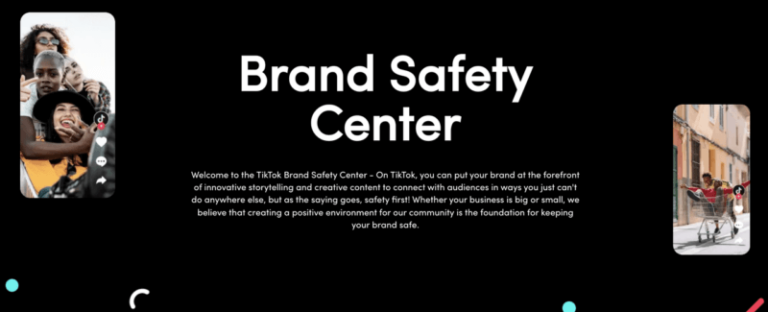
TikTok’s brand safety center consolidates transparency updates, announcements and partnerships
The brand safety center includes TikTok’s mission statement, the latest brand safety announcements, information about its partnerships and certifications, the platform’s transparency updates and case studies.
Transparency and brand safety are table stakes. Ever since the Facebook-Cambridge Analytica data scandal, social media platforms have been under increased scrutiny. Users want to be reassured that their personal data isn’t being used without their permission, regulatory bodies seek to enforce election laws and anti-collusion regulations, and advertisers want to ensure that they’re staying compliant while avoiding unwanted ad placements.
As a result, transparency and brand safety initiatives such as this have become ubiquitous for social media platforms: Facebook introduced its transparency center in May 2021. LinkedIn has transparency reports. Twitter also has a transparency center.
The future of brand safety on TikTok. Over the next year, the platform expects to work with entities within the industry to set definitions and standards for brand safety issues, like misinformation and ad adjacency.
Source: TikTok’s brand safety center consolidates transparency updates, announcements and partnerships
YouTube Rolls Out New Metadata For Educational Videos
YouTube creators can now optimize educational videos with additional metadata that will be displayed in search results in the future.
This update was announced during YouTube’s weekly news roundup that includes a number of smaller changes for creators that are worth knowing about.
Here’s a recap of the latest news for YouTube creators, starting with the metadata update.
New YouTube Metadata For Educational Videos
The new metadata fields include:
- Type of video
- Academic system
- Education level
- Exam, course or standard
Each of these fields are optional. You can utilize some, all, or none of them during the upload process.
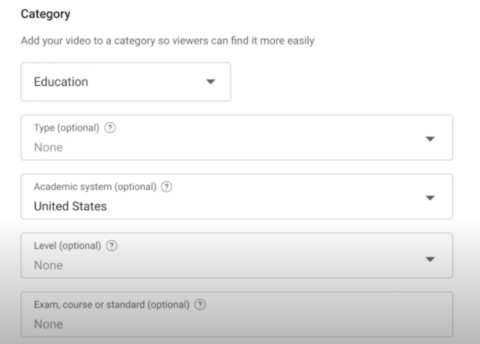
Other Updates For YouTube Creators
Custom Thumbnails On Mobile

YouTube is giving creators the ability to add custom thumbnails when uploading videos using the mobile app.
Dedicated Shorts Shelf On Desktop
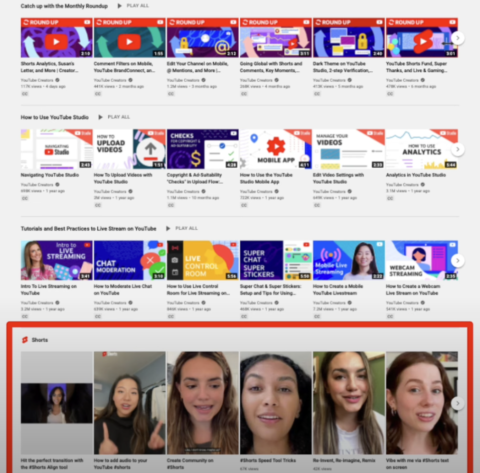
YouTube channel pages on desktop will now have a dedicated section for all the creator’s Shorts videos.
Source: YouTube Rolls Out New Metadata For Educational Videos
Google releases Data Studio Dashboard for Web Stories
Google has created a Data Studio sample template called the Web Stories Insights Dashboard. It provides an overview of how your Google Web Stories are performing.
Web Stories are visual, tappable full-screen mobile stories that can be found via Google Search and Discover.
Metrics you can view in Web Stories Insights Dashboard. There are two main tabs: Overview and Story Level. Among the metrics you can view on this dashboard:
- Key Metrics: Story starts, page views, time spent and completion rate (number of story completions divided by story starts).
- Audience Metrics: Age, gender and device.
- Top Stories: Your top 10 stories during a selected time period, sorted by Story Starts.
- Traffic Channels: An overview of how users have found and read your Web Stories – organic search, direct (which includes Discover), referral, social, email, or custom.
- Story Level Performance: Key metrics and a breakdown of pageviews for a specific story.
For this template to work, you’ll first need to set up tracking for your Web Stories in Google Analytics (or another analytics provider). For whatever editor you use to create Web Stories, you’ll need to provide your UA Tracking ID. After you’ve done this, you can view performance metrics by navigating to Behavior > Events > Overview.
Then you’ll be able to see metrics including story starts, time spent, story pages viewed and story completions:
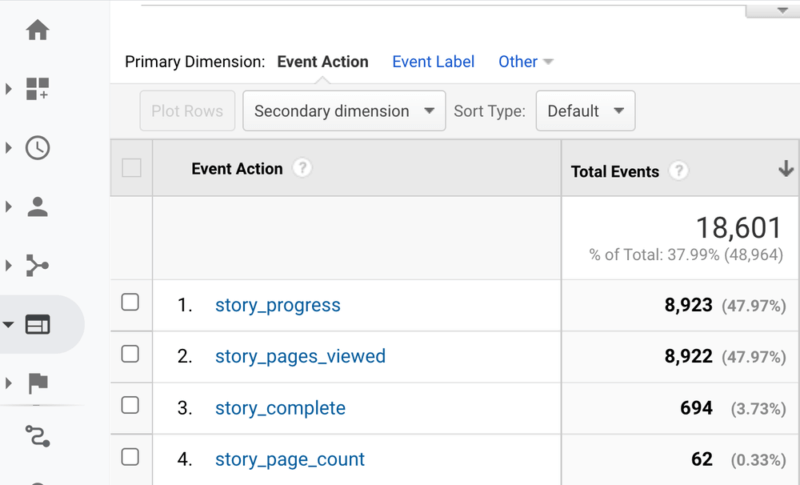
What the Web Stories Insights Dashboard looks like. This:
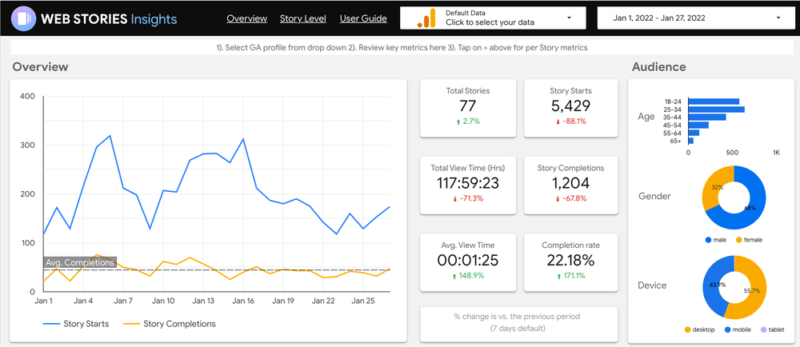
How to get the dashboard. You can access the dashboard here.
Once you get there, simply select your analytics account from the dropdown to see your data. Also, you can copy the template and customize it to your liking.
Source: Google releases Data Studio Dashboard for Web Stories
Google Ads Announces Top 3 Priorities for 2022
As buyer behavior continues to shift throughout the pandemic, Google Ads has committed to a better experience for its users.
Google Ads announced its top three priorities for 2022: automation, measurement, and privacy.
Now, these aren’t new priorities, per say, but more so shifting how they’re focusing on each one. Let’s take a further look.
As buyer behavior continues to shift throughout the pandemic, Google Ads has committed to a better experience for its users.
Google Ads announced its top three priorities for 2022: automation, measurement, and privacy.
Now, these aren’t new priorities, per say, but more so shifting how they’re focusing on each one. Let’s take a further look.
New Opportunities With Automation
Under the Automation pillar, Google is emphasizing the use of Performance Max and Discovery campaign types.
Both campaign types focus on reaching users at scale from a single campaign. Google touts the benefits of these campaigns to include:
- More simplicity in management (less campaigns)
- Multi-channel reach
- Greater ad inventory
- Incremental conversions
The Future Of Measurement
It’s no secret that measurement has been a challenging topic for most advertisers. With the iOS 14 update, the future removal of third-party cookies, and more – new approaches to measurement will be critical for success.
Without meaningful results and data to back up your marketing efforts, it’s going to be harder to prove the value of marketing.
Google is rolling out new solutions to privacy and measurement including:
- Enhanced conversions
- Consent mode
- Conversion modeling
- Data-driven attribution
Delivering Expectations For Digital Privacy
Google has updated their privacy playbook to capture these needs both from the advertiser and user perspective. The three main highlights of this playbook include:
- Building direct relationships with customers
- Ensuring measurement remains accurate and actionable
- Keep your ads relevant
Source: Google Ads Announces Top 3 Priorities for 2022
Facebook is still underreporting iOS web conversions, but not as much as before
Facebook estimates that, in aggregate, it is now underreporting iOS web conversions by approximately 8%, down from the 15% in September 2021. The company cited increased adoption of best practices as the main reason for this improvement.
Why Facebook is underreporting. The social media company has cited Apple’s iOS privacy changes as one reason for its diminished reporting capabilities. App Tracking Transparency enables iOS users to request that apps not track their activity, which limits Facebook’s (and other apps’) ability to track users for advertising purposes.
Facebook has been very vocal about its opposition to Apple’s privacy measures and has even ran full-page newspaper ads against the changes.
Recommendations for better web conversion campaign reporting. For more accurate conversion reporting, Facebook recommends that advertisers running web conversion campaigns:
- Integrate with the Conversions API – This can create a direct connection between your marketing data (from your server, website platform or CRM) and Facebook.
- Verify all domains – This can be especially important for conversions across multiple domains (i.e., websites that use redirectors or geo-redirects).
- Allow enough time before analyzing campaign performance – Due to the nature of delayed data and modeled reporting, Facebook recommends waiting at least 72 hours (or the full length of the optimization window you’ve selected) before evaluating performance.
- Align conversion events with campaign priorities – The order of your events in Event Manager should reflect your priorities (e.g., if purchases are your most valuable goal, ensure that purchases are in the number one position).
Recommendations for better app conversion campaign reporting. For those running app conversion campaigns, Facebook recommends:
- Using a 24-hour conversion window – This helps Facebook’s systems optimize for faster and more predictable feedback cycles.
- Optimizing for your business objective – Miscategorizing your objective can make it more difficult for Facebook to optimize for that objective.
Source: Facebook is still underreporting iOS web conversions, but not as much as before
More News:
Weekly News: YouTube Giving Creators More Ways To Make Money
Weekly News: LinkedIn Rolls Out Sales Navigator Search & CRM Card Updates
Weekly News: Google Search Console performance reports data issue may impact analytics